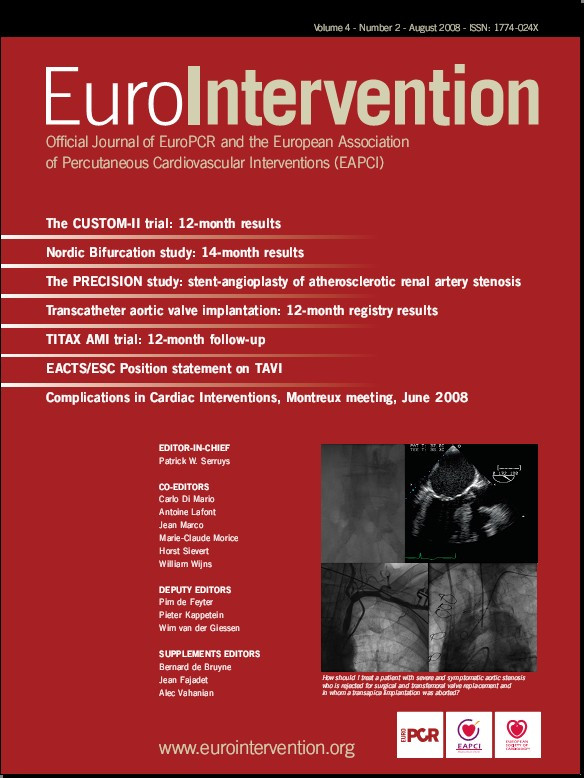“The only person who does not fall from the horse is the one that does not ride.” Based on this principle it is obvious that “the only person who does have any complications is the person who does not perform any or enough procedures”.
The majority of complications in the field of interventional cardiology result from our decision making process and from the underestimation of the downstream effect of our decisions. Based on these principles, the presentations and the discussion of our own errors should lead to an improvement of our safety record and to better patients’ care. The following papers that you will see in the “Focus” section of this issue of EuroIntervention are the fruit of labour of several years of international meetings on “Complications during PCI” organised by our cardiology department since 1998 at the University Hospital of Lausanne. Since 2001, this congress has become a joint event, co-organised with the department of cardiovascular diseases of the Mayo Clinic in Rochester, MN, USA. To celebrate our 10 year anniversary, a two days expert meeting was organised in Lausanne addressing practical recommendations for the prevention of complication during PCI. Endorsed by the European Association for Percutaneous Cardiovascular Interventions (EAPCI) and its official journal (EuroIntervention), the results of this effort are now being published here. Several areas of interest were identified and discussed engaging a group of 20 experts divided into working groups based on these topics. A short overview of each subject can be found below as well as the key elements of each paper in the journal. The full papers, as well as an extensive literature review is available on line on the journal’s website.
Group 1
DEALING WITH MAJOR COMPLICATIONS (CORONARY PERFORATION AND NO REFLOW)
An algorithm for the treatment of no-reflow and perforation was proposed and treatment alternatives were discussed. The consensus was to propose adenosine as a first line drug for the improvement of the no-flow phenomenon. Coronary perforation, although a very rare complication, carries high rates of the morbidity and mortality. Clinical predictors of coronary perforations were identified such the elderly, female gender, tortuous, calcified and small arteries. Furthermore, procedural predictors such as rotational atherectomy, the use of particular guidewires (stiff & hydrophilic wires), balloons oversizing (ratio artery to balloon of >1.2-1.3) and balloon rupture (by a jet effect) were identified.
The group proposed algorithms for the identification and treatment of these complications.
Group 2
RATIONALE USE OF ANTIPLATELET AND ANTITHROMBOTIC DRUGS DURING PCI
With respect to cardiovascular interventions, the combination of both anticoagulant and antiplatelet therapies is mandatory to prevent thrombosis because activation of both platelets and the coagulation system contribute to thrombus formation in the setting of PCI. The choice, initiation and duration of antithrombotic strategies are based on the clinical setting (elective, acute or urgent intervention). To optimise the efficacy of a given therapy and to reduce the potential bleeding hazard both, ischaemic and bleeding risks have to be evaluated on an individual basis.
Group 3
RADIATION SAFETY DURING CARDIOVASCULAR INTERVENTIONS
This group discussed the optimal methodology to reduce radiation exposure and the need for better monitoring of radiation throughout the procedure.
Group 4
PREVENTING COMPLICATIONS: A CHECKLIST
There is a growing interest in developing a checklist for medical procedures. This concept originated from the aviation industry, which is considered one of the safest industries today. The importance of creating this checklist for interventional procedure is underscored by a recent report issued by the World Health Organisation. The initial guidelines aim at reducing complications and deaths from the rising numbers of operations now being performed. Some steps in this proposed checklist might seem trivial or just simply logical. However, not following these steps can lead to complications. A physical checklist might prevent “cutting corners” or other problems related to misunderstanding or miscommunication between members of the PCI team. As we already mentioned, this checklist is not a “cookbook” list at all, but should be concretized by each individual institution according to its own policy and legislation.
The following manuscripts will provide a pathway for the prevention of complications based on the integration of evidence based medicine, guidelines and mainly personal experience along with common sense.

